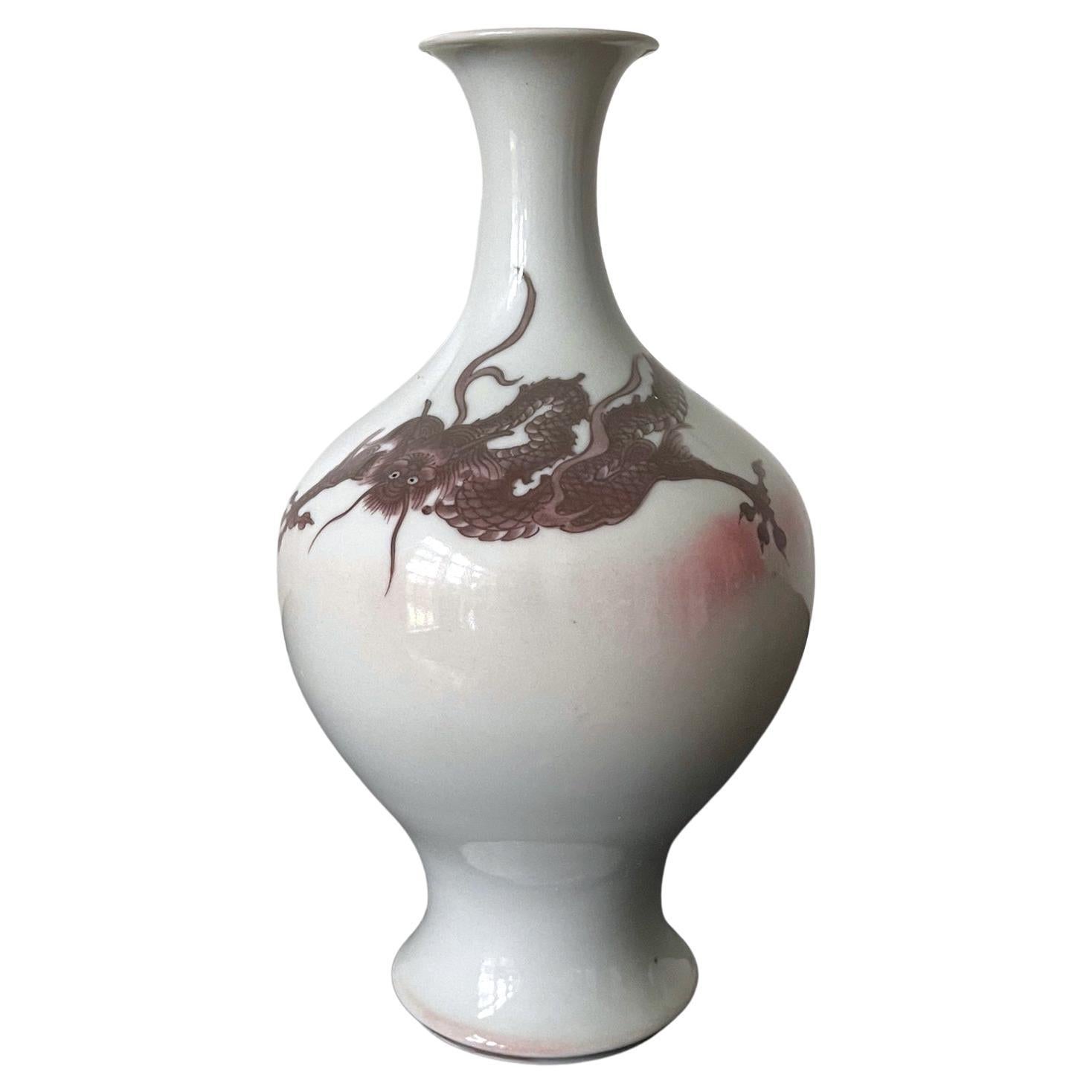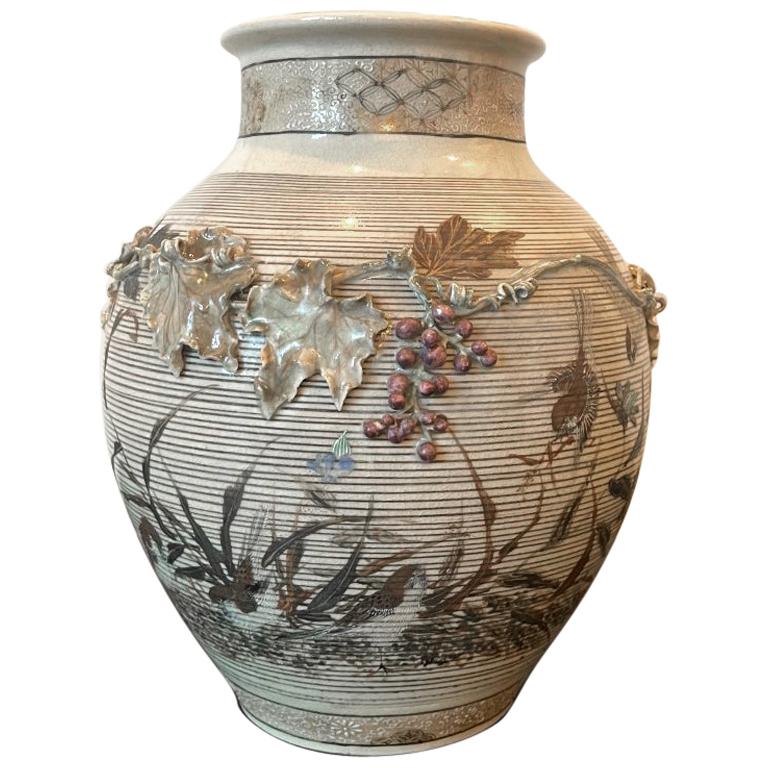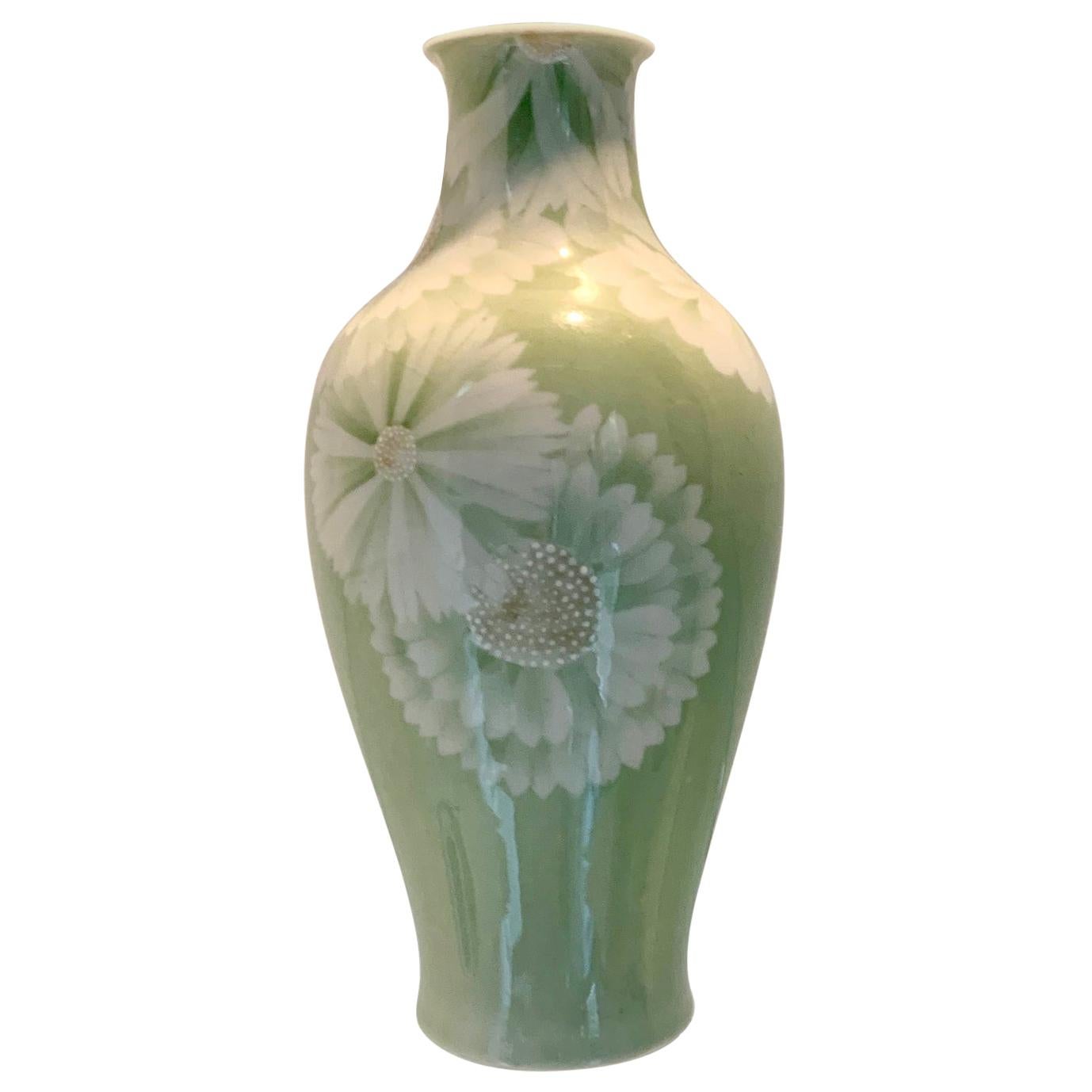Items Similar to Japanese Porcelain Dragon Glazed Vase Mazuku Kozan
Want more images or videos?
Request additional images or videos from the seller
1 of 16
Japanese Porcelain Dragon Glazed Vase Mazuku Kozan
About the Item
A porcelain vase with dragon motif by Japanese imperial potter Makuzu Kozan (1842-1916), circa 1900s. The vase is made in what is considered early phase of his underglaze period during late Meiji era. In a classic elongated baluster form, the surface of the vase was decorated in an unusual pink mist on a white and aubergine background (called Morotai, the Hazy style), on which a flying dragon is showcased on the center. The dragon was outlined in iron red and filled with the aubergine color and was artistically emphasized on its bulging eyes, claws, scales and a long tail. It was the sole focus of the design circumventing the entire body of the vase. The imagery calls in mind the dragon decoration found in Korean Buncheong pottery, with its unique folklore vitality. The craftsmanship is superb with expertly use of colors and rendering of the motion. Kozan Studio experimented with newly available colors from the west starting in the 1880s, which resulted in the expansion of the palette and style that bridged the east and west aesthetic tradition. Marked in underglaze blue on the base with a collection number in red paint.
For a similarly decorated underglaze vase, see the Japanese reference book and the page in the last two photos.
Known also as Miyagawa Kozan (1842-1916), he is one of the most established and collected ceramist from Meiji Period. Born as Miyagawa Toranosuke, Kozan established his pottery studio in Yokohama circa 1870s and later became one of the appointed artists to the Japanese Imperial household. His work was exhibited in many international fairs that the Meiji government participated at the turn of the century and won many grand prizes.
- Creator:Makuzu Kozan (Artist)
- Dimensions:Height: 11 in (27.94 cm)Diameter: 5 in (12.7 cm)
- Style:Japonisme (Of the Period)
- Materials and Techniques:
- Place of Origin:
- Period:1900-1909
- Date of Manufacture:1890s-1900s
- Condition:Wear consistent with age and use. Fine condition with minimal wear. Marked number on the base as shown.
- Seller Location:Atlanta, GA
- Reference Number:1stDibs: LU945019280422
About the Seller
5.0
Platinum Seller
These expertly vetted sellers are 1stDibs' most experienced sellers and are rated highest by our customers.
Established in 2006
1stDibs seller since 2010
477 sales on 1stDibs
Typical response time: <1 hour
- ShippingRetrieving quote...Ships From: Atlanta, GA
- Return PolicyA return for this item may be initiated within 2 days of delivery.
More From This SellerView All
- Japanese Porcelain Glazed Vase with Dragon Design Mazuku KozanBy Makuzu KozanLocated in Atlanta, GAA porcelain vase with dragon design by Japanese imperial potter Makuzu Kozan (1842-1916), circa 1900s. The vase is made in what is considered early phase of his underglaze period during late Meiji era. In a classic baluster form, the surface of the vase was decorated with a slithering dragon in underglaze iron red circulating the exterior among pink clouds. The animated rendering of the dragon is fine and detailed, with five claws, scales, long tails and highlighted eyes. The pink cloud is misty and called Morotai or the hazy style, created with a unique technique developed in Kozan's studio called fuki-e by blowing the pigment powders onto the surface. Kozan Studio experimented with newly available colors from the west starting in the 1880s, which resulted in the expansion of the palette and style that bridged the east and west aesthetic tradition. Marked in underglaze blue on the base. Known also as Miyagawa Kozan...Category
Antique Early 1900s Japanese Japonisme Ceramics
MaterialsPorcelain
- Large Japanese Blue and White Vase by Mazuku Kozan Meiji PeriodBy Makuzu KozanLocated in Atlanta, GAA striking blue and white vase from the studio of Japanese Potter Makuzu Kozan, also known as Miyagawa Kozan (1842–1916), one of the most established and collected ceramist from Meiji Period. Born as Miyagawa Toranosuke, Kozan established his pottery studio in Yokohama around 1870s and later became one of the appointed artist to the Japanese Imperial household. His work was exhibited in many international fairs that the Meiji government participated at the turn of the century and won many grand prizes. With a relative large size, this vase is decorated with underglaze cobalt blue using the novel technique developed by Kozan called Fuki-e (the blow painting), in order to achieve the striking dimensional misty winter landscape. The pine trees with upright trunks and down-sweeping branches appear receding into the depth of the mist, forming an visually unending forest. Known as one of the most creative ceramists, around 1880s, Kozan started experimenting with new chemical colors from the West in the format of his porcelain glaze. New colors allowed him to create underglaze design that appeared bright, smooth and glossy. He even invented his own receipt of cobalt blue to achieve a much brighter yet softer shade, as evident on this vase. To create landscape that is realistic and dimensional, more common in the western paintings, he was inspired by the native Japanese ink painting technique developed around 1900 by Yokoyama...Category
Early 20th Century Japanese Japonisme Ceramics
MaterialsPorcelain
- Japanese Porcelain Vase Makuzu Kozan Meiji PeriodBy Makuzu KozanLocated in Atlanta, GAA striking blue and white vase from the studio of Japanese Potter Makuzu Kozan, also known as Miyagawa Kozan (1842–1916), one of the most established and collected ceramist from Meiji Period. Born as Miyagawa Toranosuke, Kozan established his pottery studio in Yokohama circa 1870s and later became one of the appointed artists to the Japanese Imperial household. His work was exhibited in many international fairs that the Meiji government participated at the turn of the century and won many grand prizes. Of a relatively large size, this vase is decorated with underglaze cobalt blue using the novel technique developed by Kozan called Fuki-e (the blow painting). As a result, the bamboos appear took on a three-dimensional quality as if appearing in a mist. Known as one of the most creative ceramists, circa 1887, Kozan started experimenting with new chemical colors from the West in the format of his porcelain glaze. New colors allowed him to create underglaze design that appeared bright, smooth and glossy. He even invented his own receipt of cobalt blue to achieve a much brighter yet softer shade, as evident on this vase. To create landscape that is realistic and dimensional, more common in the western paintings, he was inspired by the native Japanese ink painting technique developed around 1900 by Yokoyama Taikan...Category
Antique Early 1900s Japanese Japonisme Ceramics
MaterialsCeramic
- Japanese Porcelain Vase with Relief Surface Makuzu KozanBy Makuzu KozanLocated in Atlanta, GAA rare porcelain vase by Makuzu Kozan (1842-1916) circa 1870-81 (late Meiji period). The vase is dated to the earlier work from Kozan's studio during his early period (Takauki-ware p...Category
Antique Late 19th Century Japanese Japonisme Ceramics
MaterialsCeramic
- Rare and Large Japanese Porcelain Vase Makuzu KozanBy Makuzu KozanLocated in Atlanta, GAA striking blue and white vase from the studio of Japanese Potter Makuzu Kozan, also known as Miyagawa Kozan (1842–1916), one of the most established and collected ceramist from Meiji Period. Born as Miyagawa Toranosuke, Kozan established his pottery studio in Yokohama around 1870s and later became one of the appointed artist to the Japanese Imperial household. His work was exhibited in many international fairs that the Meiji government participated at the turn of the century and won many grand prizes. With an impressively large size, this vase was likely made and reserved as a presentation piece for one of the many expositions the studio participated in the early 20th century. It was decorated with underglaze cobalt blue using the novel technique developed by Kozan called Fuki-e (the blow painting), in order to achieve the striking dimensional literary landscape known as "Mountain and Water". Being one of the most creative ceramists, Kozan started experimenting with new chemical colors from the West in the format of his porcelain glaze around 1880s. New colors allowed him to create underglaze designs that appeared bright, smooth and glossy. He even invented his own receipt of cobalt blue to achieve a much brighter yet softer shade, as evident on this vase. To create landscape that is realistic and dimensional, more common in the western paintings, he was inspired by the native Japanese ink painting technique developed around 1900 by Yokoyama Taikan...Category
Early 20th Century Japanese Japonisme Ceramics
MaterialsPorcelain
- Japanese Porcelain Vase Meiji Period Makuzu KozanBy Makuzu KozanLocated in Atlanta, GAA finely decorated and glazed Japanese porcelain vase by Makuzu Kozan (1842-1916) circa 1900s Meiji Period. The vase is of a classic bottle form with baluster body and short neck. It was decorated with underglaze white magnolia blossom on a pleasant celadon background. The stamens of the flower were artistically rendered in a low relief, giving the design a realistic appeal with the dimension. Miyagawa Kozan...Category
Early 20th Century Japanese Meiji Ceramics
MaterialsPorcelain
You May Also Like
- Japanese Gold Imari Painted Porcelain VaseLocated in New York, NYGraceful hand decorated Japanese vase with traditional motifs and gold rimmed top., c. 1960's. Signed on bottom, Gold Imari.Category
Mid-20th Century Japanese Japonisme Ceramics
MaterialsCeramic
- Japanese Green Hand-Glazed Porcelain Vase by Master ArtistLocated in Takarazuka, JPBreathtaking Japanese contemporary signed hand-glazed decorative porcelain vase in a stunning form in striking signature red and green creating the mesmerizing signature pattern tit...Category
21st Century and Contemporary Japanese Vases
MaterialsPorcelain
- Japanese Brown Hand-Glazed Porcelain Vase by Master ArtistLocated in Takarazuka, JPOutstanding hand-glazed contemporary decorative porcelain vase in stunning shape in an impressive deep red and black with a beautiful scalloped rim, a masterpiece by a highly acclaim...Category
21st Century and Contemporary Japanese Vases
MaterialsPlatinum
- Brown Hand-Glazed Porcelain Vase by Japanese Master ArtistLocated in Takarazuka, JPHand-glazed contemporary decorative porcelain vase in stunning shape in an impressive deep red and black with a beautiful scalloped rim, a masterpiece by a widely acclaimed award-win...Category
21st Century and Contemporary Japanese Vases
MaterialsPorcelain
- Pair Small Chinese Dragon Vases, Molded and Glazed Porcelain, Republic PeriodLocated in Austin, TXA fabulous pair of small Chinese molded and glazed biscuit ware porcelain dragon vases with loose eyes and apocryphal Qianlong mark, Republic Period, circa 1920, China. The small ...Category
Vintage 1920s Chinese Qing Ceramics
MaterialsPorcelain
- Japanese Glazed Ceramic VaseLocated in Palm Desert, CAVery unique tall Japanese vase with abstract pattern in a variety of brown tones. The deepest brown glaze is raised, giving the vase a wonderful tac...Category
Late 20th Century Japanese Organic Modern Vases
MaterialsCeramic





